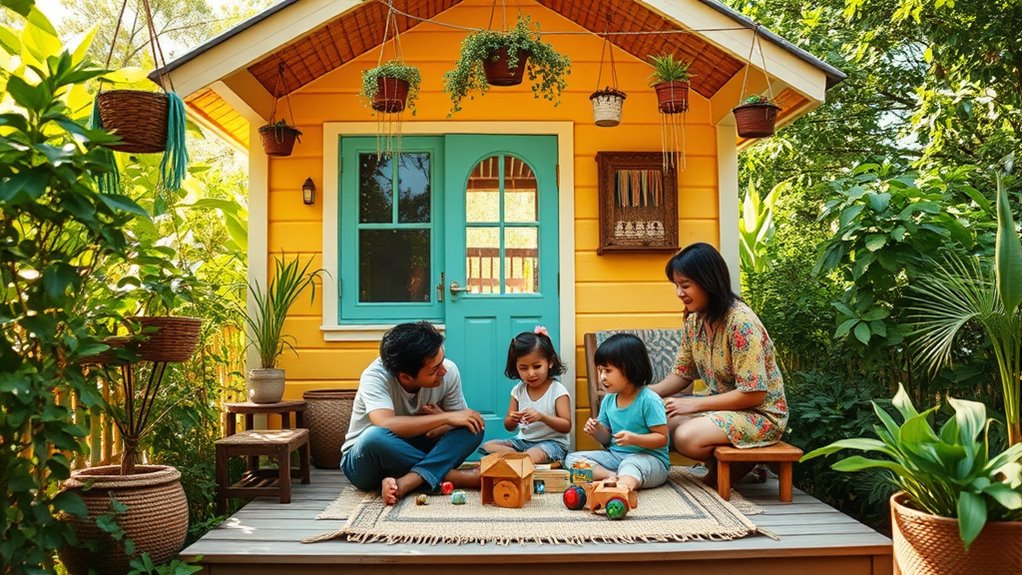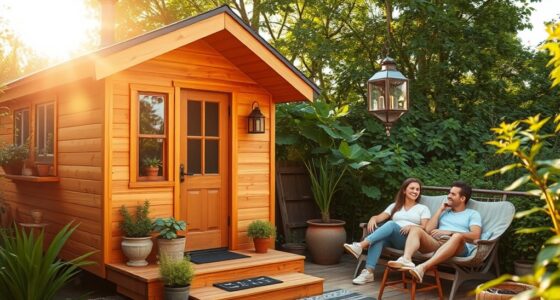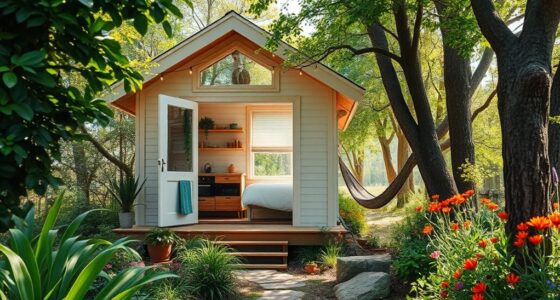Around the world, families find that tiny homes help strengthen bonds and reflect their cultural values through smart, space-efficient designs. From Japanese minimalist accents to Scandinavian functionality, each story showcases how regional styles and environmental needs shape living spaces. Many adapt their tiny homes to climates and customs, creating cozy, practical environments. Curious to see how different cultures personalize small living? Keep exploring to discover inspiring family stories from across the globe.
Key Takeaways
- Families worldwide share stories of transforming small spaces into functional, multi-purpose homes inspired by local cultures.
- Cultural influences shape how families utilize tiny homes for social gatherings, traditions, and daily routines.
- Environmental adaptations, like insulation or open-air designs, reflect regional climates and cultural values.
- Tiny house stories often highlight resourcefulness and community-building within diverse cultural contexts.
- Modern technology integration enhances family living experiences across different regions, supporting efficiency and comfort.

Have you ever wondered what life is really like for families choosing to live tiny? It’s a lifestyle that’s about more than just saving space; it’s a way to rethink how you live, prioritize, and connect. When you step into a tiny house, you quickly realize that space optimization becomes essential. Every square foot is carefully designed for multi-functionality, with furniture that folds away, built-in storage that makes clutter disappear, and open layouts that maximize every inch. Instead of sprawling rooms, you find yourself living in a cleverly arranged environment where everything has a purpose. This isn’t just about fitting into a small space—it’s about creating a home where simplicity and efficiency enhance your daily life. The way families adapt their spaces often reflects their cultural backgrounds and the specific environmental conditions of their regions. Cultural influences play a significant role in shaping these tiny house stories. In some parts of the world, the design might reflect traditional architecture, with compact, efficient structures inspired by local materials and building techniques. For example, in Japan, tiny homes often incorporate minimalist aesthetics influenced by Zen principles, emphasizing tranquility and harmony with nature. Meanwhile, in Scandinavian countries, functionality and clean lines dominate, reflecting their design ethos of practicality and minimalism. These cultural influences inform not only the structure but also the way families live within their tiny homes. For some, the small space encourages stronger family bonds—everyone shares close quarters, which fosters communication and teamwork. For others, cultural norms around hospitality and communal living shape how they use their tiny space for gatherings and social activities. Living tiny often means adapting to local customs and environmental conditions. In warmer climates, families might opt for open-air designs or outdoor living spaces that extend the home’s footprint. In colder regions, insulation and efficient heating become priorities, influencing the layout and materials used. These choices are deeply rooted in local cultural influences, which guide how families optimize their space for comfort and practicality. Interestingly, the integration of technology can also improve space efficiency and enhance living conditions in tiny homes. The decision to live tiny is often driven by a desire to connect more deeply with the environment and community, reflecting cultural values around sustainability and resourcefulness. Ultimately, by understanding space optimization and cultural influences, you see that tiny house living isn’t just a trend—it’s a thoughtful response to modern needs. Families across the globe adapt tiny spaces to reflect their unique cultural identities and practical lifestyles. They prove that living small can mean living intentionally, with a focus on quality over quantity. It’s about making the most of what you have and creating a home that truly fits your way of life.
Frequently Asked Questions
How Do Tiny House Families Handle Storage Challenges?
You handle storage challenges by using clever storage solutions and organizational strategies that maximize every inch of space. You incorporate multi-purpose furniture like beds with built-in drawers, wall-mounted shelves, and under-stair storage to keep things tidy. You also declutter regularly, prioritize essentials, and utilize vertical space to make your tiny home functional. These tips help you stay organized and make the most of your limited area effortlessly.
What Are the Financial Benefits of Tiny House Living?
Living in a tiny house can boost your financial independence by substantially reducing your living costs. You’ll save on rent or mortgage payments, property taxes, and utility bills, leading to substantial cost savings. These reduced expenses allow you to allocate funds toward savings, travel, or other priorities, giving you more control over your finances. Embracing tiny house living not only cuts costs but also promotes a simpler, more intentional lifestyle.
How Do Tiny House Families Manage Privacy and Personal Space?
You manage privacy and personal space in a tiny house by setting clear privacy boundaries and using smart space strategies. You can create designated zones for work, relaxation, and sleep, using curtains or partitions to separate areas. Respect each other’s personal space by establishing routines and boundaries, ensuring everyone feels secure and comfortable. These strategies help you maintain a sense of privacy and personal space despite limited square footage.
What Legal Hurdles Do Tiny House Families Face Worldwide?
Facing formidable legal hurdles, tiny house families fight zoning restrictions and building codes that often forbid compact, creative living. You might encounter confusing codes that restrict where you can park or build your tiny home, making it tough to secure permits. These legal labyrinths challenge your desire for independence, demanding diligence and dedication to navigate bureaucratic barriers, but persistence can pave the way to peaceful, permitted tiny living.
How Do Tiny House Families Plan for Long-Term Sustainability?
You plan for long-term sustainability by prioritizing community integration and reducing environmental impact. You build strong local connections, participate in community projects, and choose eco-friendly materials to minimize your footprint. You also incorporate renewable energy sources, water conservation systems, and sustainable waste management. By actively engaging with neighbors and maintaining eco-conscious habits, you guarantee your tiny house lifestyle remains viable and beneficial for both you and the environment over time.
Conclusion
Across the globe, tiny house families prove that less truly can be more. Did you know that over 10% of tiny homeowners say their lifestyle has markedly improved their overall happiness? By embracing small living, they find freedom, connection, and sustainability. So, whether you’re dreaming of downsizing or just curious about tiny house life, remember that these stories show how simplicity can lead to a richer, more intentional way of living. Maybe it’s time to think small.








